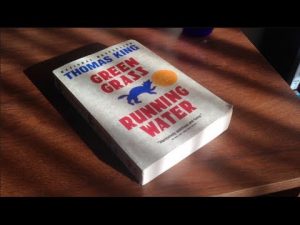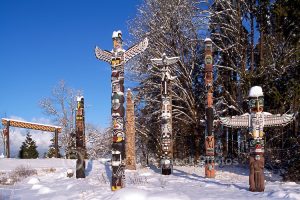 As I was looking for a page range to choose for this assignment I struck by just how much allusion is in Green Grass Running Water. I am so amazed by how much reference to outside stories, characters, sources and concepts King manages to compact in this text; I feel his writing style is analogous to hyperlinking. After much consideration, I finally decided to investigate pages 229 to 238. And here is what I found…
As I was looking for a page range to choose for this assignment I struck by just how much allusion is in Green Grass Running Water. I am so amazed by how much reference to outside stories, characters, sources and concepts King manages to compact in this text; I feel his writing style is analogous to hyperlinking. After much consideration, I finally decided to investigate pages 229 to 238. And here is what I found…
Naming – “This according to Robinson Crusoe” (King 231).
As I discussed in one of my earlier assignments, King uses the naming of his characters to support in his novels endeavor to unite First Nations story traditions and Western literature. Jane Flicks, “Reading Notes for Thomas King’s Green Grass, Running Water”, highlights the abundance of characters throughout the novel whose names directly and indirectly connect them to characters, concepts and stories of western literature; for example, Robinson Crusoe, Lone Ranger, and Ishmael. Through the naming of his characters King provides allows the western listener/reader an opportunity to experience, connect and better understand Indigenous characters and storytelling. The characters’ names are a way for King to allude to ideas and concepts that help develop a deeper understanding of the character and their position in the novel. This technique is very similar to hyperlinking; in that it allows the reader an opportunity to delve deeper into the characters and uncover the multitude connection and meanings behind the name.
Personification – “the day rolled over and took a breath” (King 233).
Personification of nonhumans and objects can be found throughout Green Grass Running Water. Near the beginning of my selected pages, I was not surprised by King’s personification of the River, the Rocks, and the Trees while telling the story of Thought Woman and the River. But, as I read through these 10 pages I noticed that he goes on to personify so many other nonhumans and objects; including, the sun, the sky, the day, light, a border building, a flag pole. I perceived that King’s use of personification is very deliberate, as Mareike Neuhaus explains, King consciously uses personification as a way to “reinforce Indigenous worldviews by reflecting the Indigenous notion that humans and non-humans are equal to one another”(171). Using personification is a way for King to allude to deep values and morals without expressly discussing them. Thought this constant personification he promotes an atmosphere of respect, responsibility and equality not just between human and the earth, or human and living things, but between human and ALL things.
Thought Women and the River – “Hee-hee, says that River. Hee-hee” (King 232).
While researching the allusions embodied by Thought Woman, I came across many different explanations of her significance; such as, Thought Woman as a representation of Mary, or Thought Woman “a figure from Navajo mythology” and creator of the world (Flick). But, I was stuck by a very different impression of the story of Thought Woman and the River when I reread it on its own, excluded from the rest of the pages. I saw Thought Woman as a representation of our (all peoples) inner dialogue; our ability for critical thinking, imagination, judgement and acceptance. And I saw that tricky River as the western culture; the societal norms, standards, rule and stereotypes, that demand we fit in, “swim to the middle” (King 231) and follow the current.
Babo – “ ‘What do you think?’ said Babo. ‘Omen or miracle?’ ” (King 238).
Perhaps the most obvious, and discussed, allusion accompanying Babo is the reference to Melville’s Benito Cereno. King’s Babo mirrors Melville’s Babo who is the leader of a slave rebellion that convinces the Captain of the ship into thinking everything is fine. This direct reflection can be seen in these pages as Babo travels along with Dr.Hovaugh in his search for the four Indians, when she is the one who assisted the four Indians with their escape.
However, in these pages the character of Babo is also used to offer a deeper reference. On page 237 the border guard refers to Babo as Dr.Hovaugh’s property saying, “‘All personal property has to be registered.’” This situation alludes to the obvious racial hierarchy of western society, and in this moment Babo’s character is used to provide a commentary on the systemic racism active in Canada and the US.
 Use of Coyote – “ ‘Is it time to be helpful?’ says Coyote” (King 229).
Use of Coyote – “ ‘Is it time to be helpful?’ says Coyote” (King 229).
Finally, one cannot read Green Grass, Running Water without evaluating King’s use of Coyote. Throughout the novel Coyote is used as the embodiment of the connection between reality and the spiritual. This use of Coyote helps is one of the ways in which King’s writing style and characters are used to mimic the novels intention to blur the distinction between the ‘mythical’ and ‘realistic.’ But, in these pages it seems as though King uses Coyote to substitute for the reader as a participant in the text; he provides a reactive commentary, is used to ask questions, and is provoked to think deeper in response to the story of Thought woman, and much like the reader, Coyote is eager to contribute to the story but it is not his turn share (King 230).
Throughout this assignment I was amazed at how much can be found in just 10 pages of King’s novel. In just 10 pages King was able to encourage the reader to actively participate in the stories by not only providing allusions to outside ideas, text and characters, but by offering a deeper commentary on western culture and Indigenous worldviews.
Works Cited
Clack, Lucian. “The Power of Conformity.” GenderTerror. N.p., 2016. Web.
15 Nov. 2016.
Cliffs Notes. “Benito Cereno -Story Summary.” CliffsNotes. N.p., n.d. Web.
16 Nov. 2016.
Flick, Jane. “Reading Notes for Thomas King’s Green Grass Running Water.”
Canadian Literature 161-162. (1999). Web. 9 Nov. 2016.
Galabuzi, Grace. “The Contemporary Struggle against Racism in Canada.”
Canadian Dimensions. N.p., 2004. Web. 15 Nov. 2016.
Garlikov, Rick. “Uses and Importance of Hyperlinks.” Writing Linearly
and With Hyperlinks. N.p., n.d. Web. 15 Nov. 2016.
King, Thomas. Green Grass Running Water. Toronto: Harper Collins,
1993. Print.
Neuhaus, Mareike. “That’s Ravens Talk”: Holophrastic Readings of
Contemporary Indigenous Literature. Regina: Canada Plains Research Center,
2011. Print.
Nicole, Courtney. “Green Grass, Running Water.” Green Grass, Running Water.
Blogspot, 2009. Web. 16 Nov. 2016.
“Native Languages of the Americas: Navajo Legends, Myths, and Stories.” Native-
Languages.org. Native Languages of the Americas Website, n.d. Web.
16 Nov. 2016.
Petkova, Veneta Georgieva. How Thomas King Uses Coyote in His Novel Green
Grass, Running Water. N.p.: Háskóli Íslands Hugvísindasvið – Canadian Literature,
2011. PDF.
Wagner, Hannah. “ASSIGNMENT 3.5 – IT’S ALL IN THE NAME.” A Look at
Canada. UBC Blogs, 2016. Web.